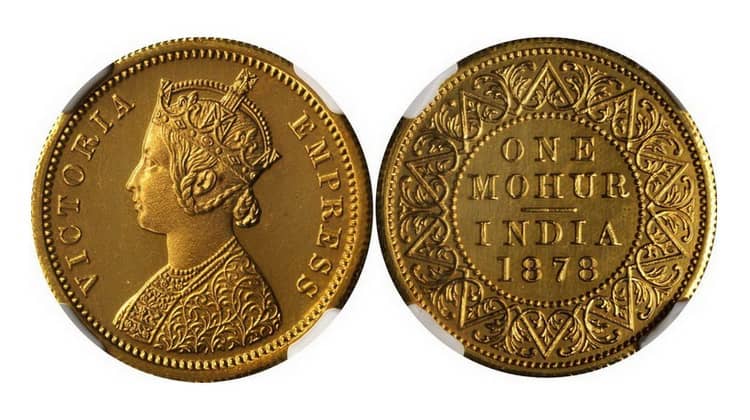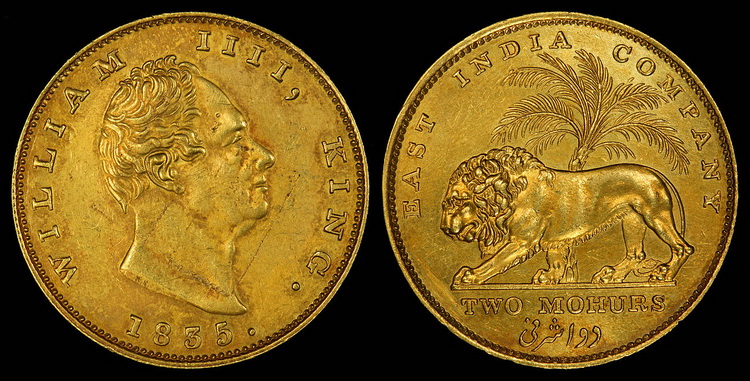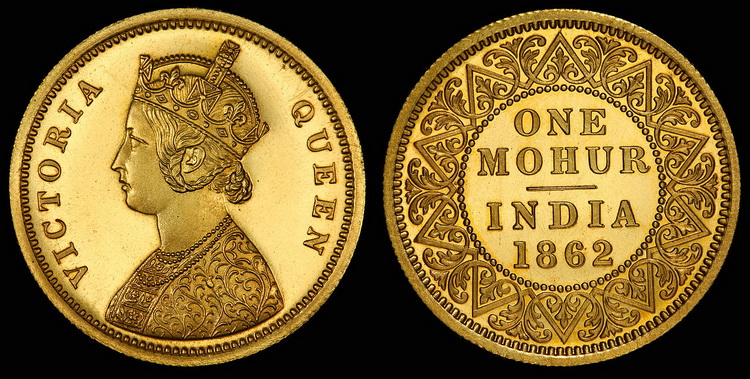
1 Indian mohur is a gold coin, popular among collectors and investors. The first copies appeared in the XVI century and almost immediately spread throughout India, Nepal and Afghanistan, and then were used by Great Britain during the East India Company. At the present time, commemorative samples are produced at the Mint of this country − 1 Indian mohur in quality Proof in limited quantities.
History
For the first time, 1 mohur was minted in 1562 under the rule of Akbar the Great (Mughal Third Emperor). The grandson of the founder of the dynasty, by conquest, expanded the borders of his state and strengthened the power of the Mughal on Indian territory. The boundaries of his possessions spread across the lands of North and Central India. At the same time, a Muslim currency appeared in the country − gold coins with a characteristic oriental pattern.
Did you know? During the reign of Akbar the Great, 1 gold mohur was distinguished by a variety of pictures and exquisite designs. This is due to the fact that the ruler did enough for the cultural development of the countries in the Mogul possession. His policy of religious and cultural diversity helped him gain the support of non-Muslim sectors of society. He was the one who made the revolution in art, painting and architecture in the style of the great Mughal.
The ornaments and inscriptions were present on the surface of the coins, but there were no images (according to Muslim canons, the image of living beings was forbidden anywhere). During the time of the Mughal domination, a lot of mohur of all kinds of design were minted. Some of them are rather difficult to identify, since there were many rulers, and each coined their own version. In addition, any resident of India could visit the Mint with a piece of gold and ask them to mint a sample to their own taste. In 1658–1707 the image was supplemented with the year of chasing.

At the time of the Great Mughal 1 mohur had a high sample (not less than 98%), which was not entirely characteristic of gold specimens of that period. In the XVI century, the maximum purity of the precious metal in coins of other countries, by tradition, did not exceed 90%. The weight of the coin was also impressive − 11.664 grams (10.692 grams of pure gold). The first copies were minted in both round and square form. Later only round option was saved.
Did you know? Like the ideology of Akbar the Great, his coins also reflected secularism. The Hindu symbol of the saustica can be found on many gold specimens along with “Six Kalimas” (Islamic confirmation of the faith). Under it, a gold coin was issued in denominations of 1/2 mohur with images of Rama and Sita. On some silver coins, the words “Rama” and “Gobind” were present.
After the weakening of the Mughal rule, many Indian rulers began minting their own mohur of gold. The design was constantly changing until the East India Company introduced its own coin variants. In 1765, the first 1 gold mohur was released at the Mint, and in 1835 the British adopted a single standard. The image of the monarch appeared on the surface of the gold sample. Together with it, the colonialists minted another gold coin 1 Indian pagoda.

Standardized coin’s value:
- 1 mohur − 10 Indian rupees − made of silver
- 1 rupee − 16 anna
- 1 anna − 4 paise.
1 Indian gold mohur was in circulation until 1918, and then the country changed its standard and the coinage had to be suspended.
The composition of the money was no longer included either gold or silver.
Did you know? One gold mohur was minted in several large Indian cities at once − Delhi, Mumbai, Calcutta and Hyderabad. A special symbol was present on the surface of such a coin − the Mint sign, indicating where it was minted. The sign is on the front side − under the year of coinage. It can be the initial letter of a city or a special symbol. A dot means that 1 gold mohur was produced in Delhi, a diamond in Mumbai, a split diamond in Hyderabad, and if any symbol is missing, then a coin is minted in Calcutta.
Design
1 Indian Mohur Akbar the Great
Material: gold (98%).
Weight: 11,664 g.
Diameter: 24 mm.
Obverse: classical Arabic ligature.
Reverse: classic Arabic script.
1 Indian Mohur East India Company
Material: gold (91.7%).
Weight: 11.66 grams.
Diameter: 24 mm.
Obverse: in the center there is the portrait of Her Majesty Victoria, The Queen of Great Britain. In the upper part there is the inscription “VICTORIA QUEEN”, in the lower part − the year of mintage.
Reverse: in the center there is a lion on the background of a palm tree. Under the picture there is the inscription “ONE MOHUR”, above the lion there is the inscription “THE EAST INDIA COMPANY”.

1 Indian Mohur minted in 2014
Material: gold (99.99%).
Weight: 11.66 grams.
Diameter: 26 mm.
Obverse: in the center there is the portrait of Her Majesty Elizabeth II, The Queen of Great Britain. At the top of the inscription “QUEEN ELIZABETH II”, “ST. HELENA “, below − the year of mintage “2014”.
Reverse: in the center there is a lion on the background of a palm tree. Under the picture there is an inscription “ONE MOHUR”, above the lion there is an inscription “THE EAST INDIA COMPANY”, “1 POUND”.
Circulation
1 Indian Mohur of the East India Company by year:
- 1862 − 153,000 pcs .
- 1875 − 11,000 pcs .
- 1877 − 10,000 pcs .
- 1879 − 19,000 pcs .
- 1881 − 23,000 pcs .
- 1882 − 12,000 pcs .
- 1884 − 8,643 pcs .
- 1885 − 15,000 pcs .
- 1888 − 15,000 pcs .
- 1889 − 15,000 pcs .
- 1891 − 17,000 pcs.
Did you know? The design of the 1st mohur of the time of the East India Company always differed depending on the year the coin was minted. On samples produced before 1875, there is a portrait of Queen Victoria. Beginning in 1870, the empress’s bust was minted on the surface of the coin. In 1876, Queen Victoria received the title “Empress of India”, and since 1877 the picture on the obverse of all Indian coins was replaced by “Empress Victoria”. Gold 1 mohur with a new picture produced between 1877 and 1891.
Coins of 1 mohur of gold were minted at three Mints of India. 32,000 samples were minted in Madras, 601,000 pieces in Calcutta, and 5,960 pieces in Bombay.
Did you know? India gained independence from Great Britain on August 15, 1947, and the first private money (coins and rupee notes) began to be minted only in 1950.
Modern 1 Indian gold mohur of 2014 were minted in the circulation of 500 samples.
Cost of coins
1 mohur times Akbar the Great is a significant rarity. Its value at the auction is approximately 5,000- 7,000 $ USD as VF and XF (depending on the state of preservation on the Sheldon scale).
The average cost of 1 Indian mohur of gold since the East India Company ranges from 1,750 to 20,000 $ USD. These numbers can also change, since some of the samples are perfectly preserved, while on others the identification marks are barely distinguishable.
Did you know? During the period of the East India Company, coins of precious metal were minted directly under the Crown. The series, released between 1866 and 1869, served only as a trade. These coins were not recognized as legal tender.
The average cost of 1 mohur of the East India Company of varying degrees of preservation:
- 1877 − VF – 1750, XF – 2250 $ USD, MS – 3,500 $ USD
- 1878 − MS – 20,000 $ USD
- 1879 − VF – 6,000, XF – 7,000 $ USD, MS – 12,000 $ USD
- 1881-1899 − VF – 2,300 $ USD, XF – 2,700 $ USD, MS – 3,500 $ USD
In 2014, a new version of mohur was minted in India − a commemorative coin of pure gold (99.99%) as a Proof. By design, the coin is almost completely similar to its predecessor. It is highly valued by numismatists, and its price is estimated at about 1,500 $ USD.
Comments
No commens yet.